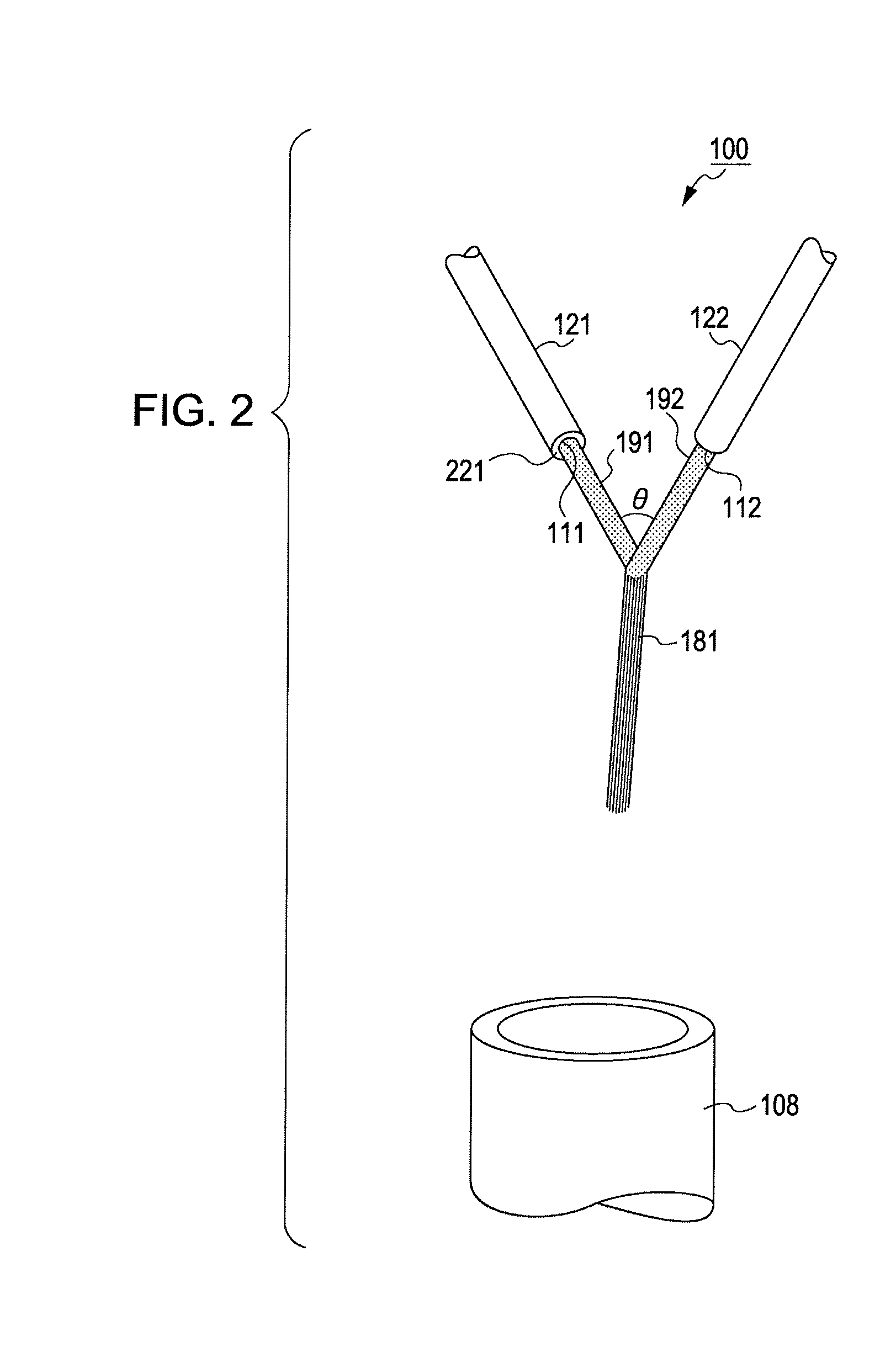Method for manufacturing dispersion and ink using dispersion obtained thereby
a technology of dispersion and manufacturing method, which is applied in the direction of liquid-liquid reaction process, transportation and packaging, mixing, etc., can solve the problem of not always easy to stably obtain a uniform dispersion for a long period of time, and achieve superior gloss, superior dispersion of pigment particles, and manufacturing stably
- Summary
- Abstract
- Description
- Claims
- Application Information
AI Technical Summary
Benefits of technology
Problems solved by technology
Method used
Image
Examples
example 1
[0107]In this example, the liquid mixing device 100 shown in FIG. 10 was used. The nozzle 121 ejecting one type of liquid was made of Teflon (registered trademark) and had an opening diameter of 300 Vm. The nozzle 122 ejecting the other type of liquid was made of glass and had an opening diameter of 470 μm. In addition, an angle made of the traveling directions of the above two liquids was set to 40°.
[0108]The liquid to be ejected from the nozzle 121 was prepared as described below. Dimethyl sulfoxide in an amount of 100 parts by weight was added to 10 parts by weight of a quinacridone pigment, C.I. Pigment Red 122, to form a suspension. Subsequently, as a dispersing agent, 40 parts by weight of sodium lauryl sulfate was added, and until the above materials were dissolved together, an aqueous solution containing potassium hydroxide at a concentration of 25% was being added to prepare a reaction liquid. As the liquid to be ejected from the nozzle 122, ion exchange water was used.
[010...
example 2
[0111]In this example, the liquid mixing device shown in FIG. 4 was used. The nozzle 122 ejecting one type of liquid was made of Teflon (registered trademark) and had an opening diameter of 200 μm. The nozzle 121 ejecting the other type of liquid was made of glass and had an opening diameter of 310 μm. In addition, an angle made of the traveling directions of the above two liquids was set to 90°.
[0112]The liquid to be ejected from the nozzle 122 was prepared as described below. Dimethyl sulfoxide in an amount of 50 parts by weight was added to 10 parts by weight of a disazo pigment, C.I. Pigment Yellow 128, to form a suspension. Subsequently, as a dispersing agent, 40 parts by weight of polyoxyethylene lauryl ether was added, and until the above materials were dissolved together, an aqueous solution containing potassium hydroxide at a concentration of 25% was being added to prepare a reaction liquid. As the liquid to be ejected from the nozzle 121, ion exchange water was used.
[0113]...
example 3
[0115]In this example, a liquid mixing device similar to that in Example 1 was used. When Pigment Yellow 83 particles were synthesized from an aqueous 3,3′-dichlorobenzidene tetraazo solution flowing through the nozzle 121 and an aqueous coupler solution at a concentration of approximately 5% flowing through the nozzle 122, particles having a small and uniform diameter could be obtained as was the case of Example 1.
[0116]The nozzle 121 was made of Teflon (registered trademark) and had an opening diameter of 300 μm, and the nozzle 122 was made of glass and had an opening diameter of 470 μm. In addition, an angle made of the traveling directions of both the liquids 191 and 192 was set to 60°.
[0117]The liquid to be ejected from the nozzle 121 was an aqueous 3,3′-dichlorobenzidene tetraazo solution, and the liquid to be ejected from the nozzle 122 was a solution formed by dissolving polyoxyethylene lauryl ether in an aqueous coupler solution at a concentration of approximately 5%.
[0118]...
PUM
| Property | Measurement | Unit |
|---|---|---|
| Angle | aaaaa | aaaaa |
| Flow rate | aaaaa | aaaaa |
| Solubility (mass) | aaaaa | aaaaa |
Abstract
Description
Claims
Application Information
 Login to View More
Login to View More - R&D
- Intellectual Property
- Life Sciences
- Materials
- Tech Scout
- Unparalleled Data Quality
- Higher Quality Content
- 60% Fewer Hallucinations
Browse by: Latest US Patents, China's latest patents, Technical Efficacy Thesaurus, Application Domain, Technology Topic, Popular Technical Reports.
© 2025 PatSnap. All rights reserved.Legal|Privacy policy|Modern Slavery Act Transparency Statement|Sitemap|About US| Contact US: help@patsnap.com



